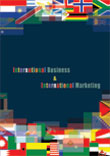International Business and International Marketing
 |
Details
Textbook:
Pages : 328;
Paperback;
210 X 275 mm approx.
Suggested Case Studies
Workbook:
Pages :
280; Paperback;
210 X 275 mm approx, Sample Applied Theory Questions
Sample Multiple Choice Questions (Online Quiz)
Pricing
Textbook Price: Rs. 750;
Workbook Price: Rs. 700;
Available only in INDIA
Buy Now
Please allow 5 to 10 days for delivery.
Detail Table of Contents
Pricing in International Markets : Chapter 12
SUMMARY:
Pricing is a value determination process for the product or service that will be offered for sale. Making pricing decisions in international markets is ridden with difficulties as it involves multiple currencies, trade barriers, additional cost considerations, and longer distribution channels. |
|
different factors such as inflation, nature of product or industry and competitive behavior, devaluation and revaluation, market demand, and transfer pricing.
Transfer pricing is the setting of prices to be charged by one unit (such as a foreign subsidiary) of a multi-unit corporation to another unit (such as the parent corporation) for goods or services sold between such related units. Transfer pricing is an important issue for a company operating internationally. It is done in three ways: market based pricing, transfer at cost, and cost-plus pricing.
"Arm's-length" pricing rule is generally followed in determining the sale price of tangible property to an affiliate. There are three methods to determine arm’s-length price: comparable uncontrolled price method, resale price method, and cost-plus method. The size of the corporate, cultural background of firms, company controls and information systems, duty and tariff constraints, and government controls are some of the constraints that determine the transfer pricing mechanism.
Firms operating in international markets follow ethnocentric, polycentric, and geocentric approaches in pricing. In the ethnocentric approach, a firm follows the same price throughout the world. A firm following a polycentric approach allows its regional managers to fix the product prices based on the circumstances in which they operate. A firm adopting a geocentric approach takes a medium position between fixing a single price worldwide and fixing different prices based on the requirements of subsidiaries.



